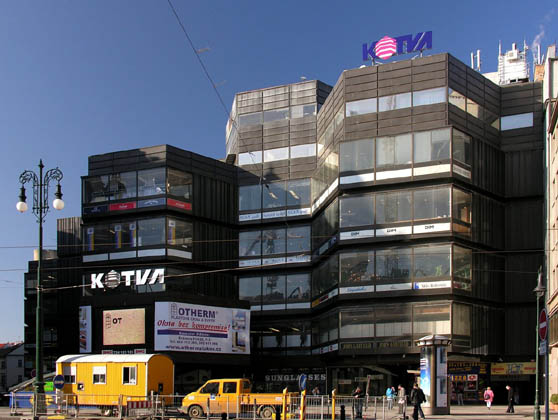
Prof. Švácha wants to declare the Prague Kotva as a monument
 |
The Máj department store, now Tesco, was opened in 1975, just two months after Kotva. Švácha submitted a proposal for the building to be declared a cultural monument last March - according to him, the building is one of the most significant examples of Czech architecture from the 1970s. The Ministry of Culture, specifically Minister Martin Štěpánek, made a definitive positive decision in early January.
The owner of Máj is not fond of the monument status and fears that he will not be able to carry out renovations as he envisions. However, Švácha believes that the declaration as a monument does not impede its modifications. He is confident that there are architects who could design a respectful renovation of Máj – including the original authors.
Kotva was built between 1970 and 1975 by the architect couple Věra and Vladimír Machonin, leading figures in post-war Czech architecture. In the 1960s, both authors gained international recognition, having won a public competition for the design of the Thermal hotel in Karlovy Vary (1965).
According to Švácha, Kotva "represents Czech architecture of the first half of the 70s at a high level." The artistic and construction approach of the building uniquely responds to stimuli from several directions in post-war world architecture, he believes. The structure consists of a reinforced concrete skeleton divided into hexagonal units that grow together in various ways, creating a spatial whole on each floor. A similar system was first used by the famous Frank Lloyd Wright before World War II. This system gained wider acceptance later; it was used by the authors of several pavilions at the 1958 World Expo. In Czech architecture, it was applied in the late 1960s by Ivo Klimeš for the theater in Most and by Karel Hubáček and Miroslav Masák for the Ještěd shopping center in Liberec.
The technical appearance of all three buildings corresponds to the trends of contemporary world architecture and possesses significant stylistic and aesthetic qualities, the historian points out. The authors emphasized the rough and raw beauty of the materials used, which has its origins in the stylistic program of the so-called new brutalism of the 50s and 60s of the 20th century. In Kotva, this is exemplified by the contrast between rough concrete, ribbed surfaces of cladding sheets, and very smooth glass.
"Věra Machoninová fully supports the initiative to declare Kotva a cultural monument," Švácha stated. The current owner of Kotva, according to her communication, is preparing an extensive renovation, without inviting her to design this action herself. "This can be considered unethical and very dangerous for the heritage value of the building," the historian believes. The owner of Kotva is the company Markland Kotva.
Like Máj, Švácha also proposed to declare the Ještěd department store in Liberec, which also belongs to Tesco, which plans a new construction after its demolition. He was not successful, while he managed to advocate for four buildings - the Ještěd transmitter, which even became a national cultural monument and aspires for UNESCO listing, the building of the Federal Assembly, a hotel house in Prague on Invalidovna, and the Institute of Macromolecular Chemistry in Prague in Petřiny.
Švácha is convinced that there should always remain a representative sample of buildings from each historical period as a fingerprint of the era. "I suppose there could be about 20 from the 70s and 80s," he believes. In addition to the mentioned buildings, he would also like to see the Prague House of Housing Culture protected. However, even with modern monuments, it is necessary to differentiate - Švácha and other experts express absolute rejection of the Congress Center.
The English translation is powered by AI tool. Switch to Czech to view the original text source.
6 comments
add comment
Subject
Author
Date
treba neskonci jako varsavsky supersam
johansen
16.02.07 10:28
Hmmm..
Johanka
17.02.07 06:31
Pripomíka k tématu
Tomša Junior
04.04.07 12:45
Problém moderních památek a žijících autorů
Mici
22.05.07 12:19
Mici - Citlivé a invenčně zpracované současné stavby
Pavel Nasadil
22.05.07 01:21
show all comments
Related articles
0
11.04.2019 | The Kotva department store has been declared a cultural monument again
0
03.04.2019 | The owner of Kotva violated the law, but he is not facing any sanctions
2
02.04.2019 | The anchor from the 70s is a distinctive building by the Machonin couple
0
02.04.2019 | The minister abolished the heritage protection of Kotva, the proceedings are held again
0
28.03.2019 | The Kotva department store is set for a year-long renovation, which is expected to start next year
4
04.10.2018 | The Kotva department store has become a monument, the proceedings are still ongoing
0
25.04.2017 | Rostislav Švácha: On Heritage Conservation and Transgas
0
08.11.2016 | The Ministry is assessing whether Kotva will become a monument like Máj
0
28.12.2015 | Prague will apply for the declaration of the Anchor as a monument in the first quarter of 2016
0
28.09.2015 | Prague wants to declare the Kotva department store a cultural monument
4
23.05.2012 | OD Kotva wants to convert two floors into offices












